 |
 |
NEWS & PRESS RELEASES

| |
|
TITLE:
The Return of the Linnaeus Apostles. At The Royal Geographical Society, London, United Kingdom.
DATE:
19th March 2007
ARTICLE CONTENT:
THE RETURN OF THE LINNAEUS APOSTLES is an exhibition and a showcase for the publication of the monumental work The Linnaeus Apostles - Global Science & Adventure in 2007. This work comprises 8 Volumes, 11 books, about 5,000 pages, and will have taken nearly 8 years to produce.
In connection with the exhibition a number of special events are also arranged for organisations, the public and the media.
The exhibition will be on display for brief periods all around the world in connection with current or future launchings of the publication and is open to the public. Media, museums, universities, schools and learned societies would benefit from its stimulating insights into the world and work of the Linnaeus Apostles.
Although Linnaeus and some of his apostles are known internationally, several of the apostles are relatively unknown despite their global pioneering work in the service of science and mankind. The publication of their journals - several of them now made available for the very first time - will for a long time to come, stimulate fresh research, new thinking and not least provide exciting reading about cultures, landscapes and people of a bygone era.
The exhibition THE RETURN OF THE LINNAEUS APOSTLES gives the visitor an insight into this exhilarating world - images, texts and maps will guide the visitor on a fascinating journey not only through natural history, but also through ethnography, geography, anthropology, cartography, history, voyaging, history of the printed book… from all the continents of the world.
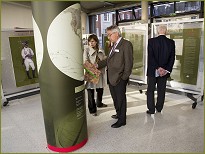 The exhibition will be on display for brief periods all around the world in connection with current or future launchings of the publication and is open to the public. Media, museums, universities, schools and learned societies would benefit from its stimulating insights into the world and work of the Linnaeus Apostles. The exhibition will be on display for brief periods all around the world in connection with current or future launchings of the publication and is open to the public. Media, museums, universities, schools and learned societies would benefit from its stimulating insights into the world and work of the Linnaeus Apostles.
At The Royal Geographical Society
Nearly 100 invited guests had come from all over Europe - from universities, museums, Linnaean societies, libraries, governments, embassies etc. - to take part in the programme at the Royal Geographical Society.
|
|
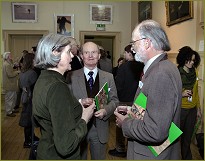
Two of the translators involved in the monumental project, from left: Mrs Eivor Cormack with husband Mr Robert Cormack, and Mr Tom Geddes |
On behalf of the IK Foundation & Company and the Embassy of Sweden, the Ambassador of Sweden, Mr Staffan Carlsson warmly welcomed all the guests to the exhibition and gave a brief account of the celebration of Carl Linnaeus and his world. Details/Speech...
Then the ambassador for the project and the IK Foundation & Company, Mr Olof G Tandberg, Foreign Secretary of The Royal Swedish Academy of Sciences 1970-1998; took over the rostrum and spoke about - Unique Apostles in a Unique Monumental Publication. Details/speech... |
|
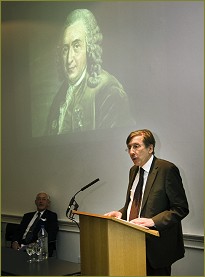
The Ambassador of Sweden, Mr Staffan Carlsson |
| Representatives from the Linnean Society of London and Sir David Attenborough were presented with a framed certificate as a sign of the scientific cooperation and inspiration on the publication of The Linnaeus Apostles - Global Science and Adventure. |
|
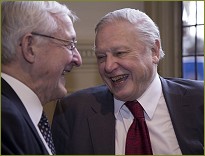
Mr Olof G Tandberg with Sir David Attenborough, at the presentation held in The Geographical Society in London
|
| |
|
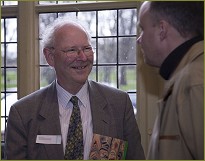
The Linnean Society of London President Professor David Cutler with The IK Foundation & Company Director and Editor-in-chief Lars Hansen, in the Hall of The Geographical Society. |
The concluding address concentrated on the first edition of Daniel Rolander's "Diarium Surinamense" - a forgotten masterpiece. By Dr James Dobreff. Latin expert, who is one of the translators involved in the project.
|
|
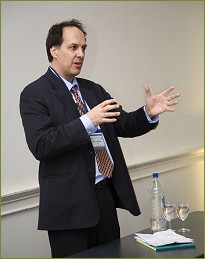
Dr James Dobreff |
SEE ALSO:
The speech by the Ambassador of Sweden, Mr Staffan Carlsson.
I am delighted to welcome you to today's event which is a showcase of the publication of the monumental research project "The Linnaeus Apostles - Global Science & Adventure".
The Embassy of Sweden in London and its partners are collaborating around a series of events to mark the tercentenary of Carl Linnaeus this year. Linnaeus dispatched his apostles on journeys all over the world - some of you represent the countries which the apostles visited.
Later this spring, in May, London will be the port of call for the life-size replica of the East India Trader Göteborgh. One of Linnaeus Apostles, Christopher Tärnström, travelled with the Swedish East India Company to East Asia. In May, you will also be able to see a Swedish Linnaeus-inspired garden at Chelsea Flower Show. The Embassy's cooperation with IK Foundation & Company is part of our Linnaeus tercentenary programme, although The Linnaeus Apostles Project has been underway for many years and it will continue for many years to come.
The eight-volume publication - comprising 5000 pages of material - includes contemporary eye witness descriptions and modern papers on aspects of the world in the 18th Century. This extraordinary material will be published for the first time in English, in October 2007 - it has taken eight years to complete the project.
The Linnaeus Apostles publication is the result of thorough international research - researchers from around the world have been invited to contribute. IK Foundation & Company has worked in cooperation with the Swedish Ministry of Foreign Affairs from the very start and the result will be presented at our Embassies throughout the world.
Through the exhibition "The Return of the Linnaeus Apostles", which you will be able to see later today, and through the events taking place here on Thursday evening, we hope that you will be inspired by Linnaeus and the extraordinary lives and achievements of his apostles.
Indeed, I hope you will be back on Thursday evening when the National Linnaeus Schools project will be presented by Dr Elisabeth Långström at 6.30, followed by a unique screening of the Swedish Television drama documentary 'Linnaeus - an Ordered Mind' at 19.30. The screening will be introduced by Professor Sverker Sörlin.
Before I pass on the word to Mr Olof Tandberg of IK Foundation & Company who serves as an ambassador for the project, and is the former international secretary of the Royal Swedish Academy of Sciences, and Dr James Dobreff, a Latin expert who is one of the translators involved in the project, I would like to thank Mr Lars Hansen, Director of IK Foundation & Company and Editor in Chief, along with all his colleagues who have been at the tiller from the very start and who have steered this unique and thrilling project into a safe harbour!
I have been told that, after the speeches by Mr Tandberg and Dr Dobreff, we will be treated to a traditional Swedish drink - Lingonberry juice - which is supposed to prevent scurvy which was common amongst travellers in Linnaeus' day. And some traditional sailor's fruitcake with cheese will hopefully keep your hunger away.
The speech by the ambassador for the project and the IK Foundation & Company, Mr Olof G Tandberg
Unique Apostles in a Unique Monumental Publication .
Your Excellencies, friends, ladies and gentlemen,
It is a great pleasure and an honour for me as a passive geographer to be making this inaugural speech in the assembly room of the Royal geographical Society of London - the leading geographical society of the world with 14,000 members from more than one hundred countries - Livingstone was a member, as were Stanley, Scott and Shackleton. There is a connection between them and the Linnaeus Apostles which I shall return to later.
With his forceful personality, the Swedish naturalist Carl Linnaeus inspired 17 of his students to travel through large parts of the then known world in order to document the local flora, fauna and culture. The 17 students covered all the continents and came to be known as the Linnaeus Apostles.
The exhibition - The Return of the Linnaeus Apostles - provides exciting proof of the apostles' scholarly work but also of their world - that of the 18th century. In addition, their extensive material has now been assembled in eight volumes, eleven books totalling approximately 5,000 pages. The work behind the publication is more than impressive - it is a major achievement.
There is a saying in Sweden that fits the exhibition well: "The difference between the possible and the impossible is that the impossible takes longer". In this case "An Impossible Project" has been achieved after nearly eight years of international co-operation. Manuscripts and forgotten letters to and from Linnaeus' 17 apostles have been collected and translated into English for the first time.
What then do these 17 young explorers have in common with those members of the Royal Geographical Society I just mentioned? The common denominator is "The Spirit of Man".
During a quarter of a century - 1745-1799 - the 17 Apostles travelled the world over. Some of them paid for it with their lives. Others succeeded by collecting plants to verify a new revolutionising method within systematic botany - Linnaeus' sexual system which maintained that a natural order existed for the plants of the world.
Besides, the Apostles brought back to Sweden and Uppsala samples of previously unknown minerals. The finds became important jigsaw pieces in the wide gathering of knowledge which was to generate financial rewards and become an early basis for what might be called the imperialism of knowledge.
The Apostles' finds altered our understanding of the botanical world and acknowledged the validity of a method which had been developed by one single person at a university which was little known at the time and not part of any pilgrimage route taken by natural historians.
This one single person - Carl Linnaeus - was from an early age bewitched by botany and its role in society. As early as the age of 18 he makes a revealing outline in a notebook which has luckily been preserved for posterity. As this little book in manuscript has a direct bearing on the Apostles' journeys I would like to say something about it. The Notebook from his senior school days was written in the year 1725 in the Swedish town of Växjö, a centre of learning in the province of Småland.
The Notebook conveys his ardent interest in botany and the usefulness of plants.
In a committed, personal style, presaging the brilliant researcher, the youth at senior school accounts for the characteristics of plants with an infectious enthusiasm which was later to beguile royalty into making bequests, students to go on excursions and 17 enthralled apostles to undertake uncertain expeditions to unknown lands.
The first page of the Notebook is dominated by a drawing of a tree in bloom. Above the tree is written in an elegant hand: "May, painter of the ground, carpeting the meadows with flowers, forest delights. May, the little heart of spring . of the year, the jewel of the seasons."
Then follows a quotation from Virgil: "Now every field, every tree grows green, now the forests come into leaf, now is the most wonderful summer."
The Notebook accounts for more than 150 different wild and cultivated Swedish plants and contains lists of the medicinal properties of precious stones, plants, oils and salves. It also includes examples of the disrespectful humour which was to flourish in Linnaeus' later works.
Below an illustration of a poppy (Papaver somniferum) you read: "From its juice opium is made which one can take in order to sleep 1, 2, 3 days without waking, [...] yes one can take so much that one does not wake until woken by God's trumpet."
The ease of the language, the accurate observations, the quick witted phrasing show that the 18 year old would later on be regarded as one of the great Swedish prose writers of the18th century.
In 1742 as professor at Uppsala University, Linnaeus begins to "lecture on botany, natural history, dietetics, diagnostics and medicine". The young professor consciously broke with medieval scholasticism and moved his lectures out of doors. His expositions were stirring and engaging. They were delivered with an ardent thirst for knowledge which attracted an increasing audience.
The young professor's excursions in the open air, the so-called "herbatories", were notable. With Professor Linneaus as a lively central figure, natural history was no longer a pastime but a significant subject at Uppsala University.
From the group of approximately 400 listeners, an inner circle gradually formed of students who were so devoted that regardless of location, privation and hardship, they were prepared to collect plants and minerals and other information for their master. The Apostles were curious about Nature and wanted to explore it. In preparation for their journeys, they were equipped with long lists of questions at issue and commissions for specifically coveted plants and minerals.
The Apostles' experiences form an indispensable part of our everyday life. Linnaeus introduced the golden age of classification. Through his Apostles' material, he was able to demonstrate that the sexual system could be applied the world over. Systematic botany provided all the plants on earth with a natural order.
There was behind the Apostles' journeys much more than a craving for adventure. Of utmost importance was the mapping of Nature's housekeeping or economy and the various interdependent organisms. In the 18th century botany was regarded as a part of medicine, the main part of all drugs being based on plants and herbs. Diseases could be cured by using desert plants, a dried Spanish fly, dragon's blood, "pestilence root" (or butterbur), banana, Siberian wild apple...
The Apostles had different professions. They were teachers, ship's physicians, clergymen, but they were all inspired by Linnaeus' forceful personality and his message of the new systematic biology. They were young - most of them between 25 and 35. The Apostles brought to life what I referred to earlier as "The Spirit of Man". That is convincingly demonstrated in their scholarly journals which are presented today especially for you.
The Apostles' view of the world was not ours. Like their master, the self-fixated clergyman's son, they were characterised by a religiosity based on the Old Testament. The norms of the Old Testament were the rule. The image of God was central and the earth was the centre of the universe. Linnaeus was convinced that through his epoch-making methods he expounded God's creation plan which was to provide order in the Almighty's Nature.
A large part of the earth's surface had by then not been discovered by Europeans. Australia and the South Seas were considered to be parts of a mythical southern continent, Terra Australis Incognita, with antipodean animals and plants and fabulously rich lands which had been described in fanciful stories from antiquity. Also unknown to Europeans were the plateaus and jungles of Latin America, the North American prairie and the Russian taiga.
Herman Moll's world atlas from 1719 was what was known. There were other cartographers, such as Thomas Jeffery and John Cary but, in his 1719 edition, Moll maintains that his world atlas was correct. The coast lines on his maps are indeed correct in the main, but the northern part of the Pacific is missing, as is the whole of north California. The African interior was unknown territory, as was Central Asia.
But Moll presents a good picture of the European view of the world. The white spots on the 18th century maps had in fact been "discovered" long ago by non-Europeans who asserted their right to live and stay in areas previously unknown to the Europeans. This serious conflict is reported in the collective volume on the Apostles under the title "One world, many Horizons".
It is also reported here how the Swedish East India Company gave free passage to Apostles and that others sailed out in Dutch, Danish and English merchant ships. That enabled the apostles to complete their research assignments.
It has been fascinating for us three "Project Ambassadors" to take part in the birth of this unique sequence of books. The three of us represent the general public, industry and the sciences. We have been privileged to follow step by step the editors' work of collecting, tracing forgotten letters, manuscripts and material complementary to the Apostles' travel journals. The documents give us a vivid insight into 18th century everyday life and into the Apostles' adventurous journeys in the service of natural history.
As one of many examples we will shortly have the opportunity to listen to one of the IK Foundation's translators, Dr James Dobreff, on the Linnaeus Apostle Daniel Rolander's Journal, a Latin text of over 600 pages, now made accessible for the first time.
That we can avail ourselves of the world of the Apostles, now long since gone, is ultimately due to the IK Foundation & Company's Director and editor-in-chief Lars Hansen. His indomitable energy, tenacity and capacity for work is completely in line with Carl Linnaeus and proves that "The Spirit of Man" lives on in our time. Warm thanks also go to IK Director Per Wahlström, members of the editorial board who have tried to bring order into the 5,000 pages, co-authors who have thrown light on the world of the 18th century and the traces it left and to all the translators who have fought their way through difficult texts in various languages. Last, but by no means least, I thank all the financiers who, like the private financiers of the apostles, have realised the significance of curiosity and knowledge that recognise no boundaries.
Curiosity about Nature and the will to explore it are still two preconditions for people to be able to understand and change our badly wounded world. Today that is more important than ever.
The IK Foundation would therefore like to show its appreciation by presenting subscriptions for this publication to two of our guests as a token of gratitude for their contribution to stimulating boundary-crossing curiosity in the spirit of Linnaeus and his apostles.
May I now ask the President of the Linnaean Society of London, Professor David Cutler, and Sir David Attenborough to come forward and receive their marks of distinction from the IK Foundation. Let us give them a warm accolade.
Now I would like to hand over to Dr James Dobreff.
|
|
 |
 |
 |
|
 |
 |
 |
Earth Moon Image © NASA |
Updated/Checked
07/07/2022 |
© The IK Foundation & Company |
 |
You are here: Home > News > Press Releases > The Return of the Linnaeus Apostles. At The Royal Geographical Society, London, United Kingdom.
|
|
|